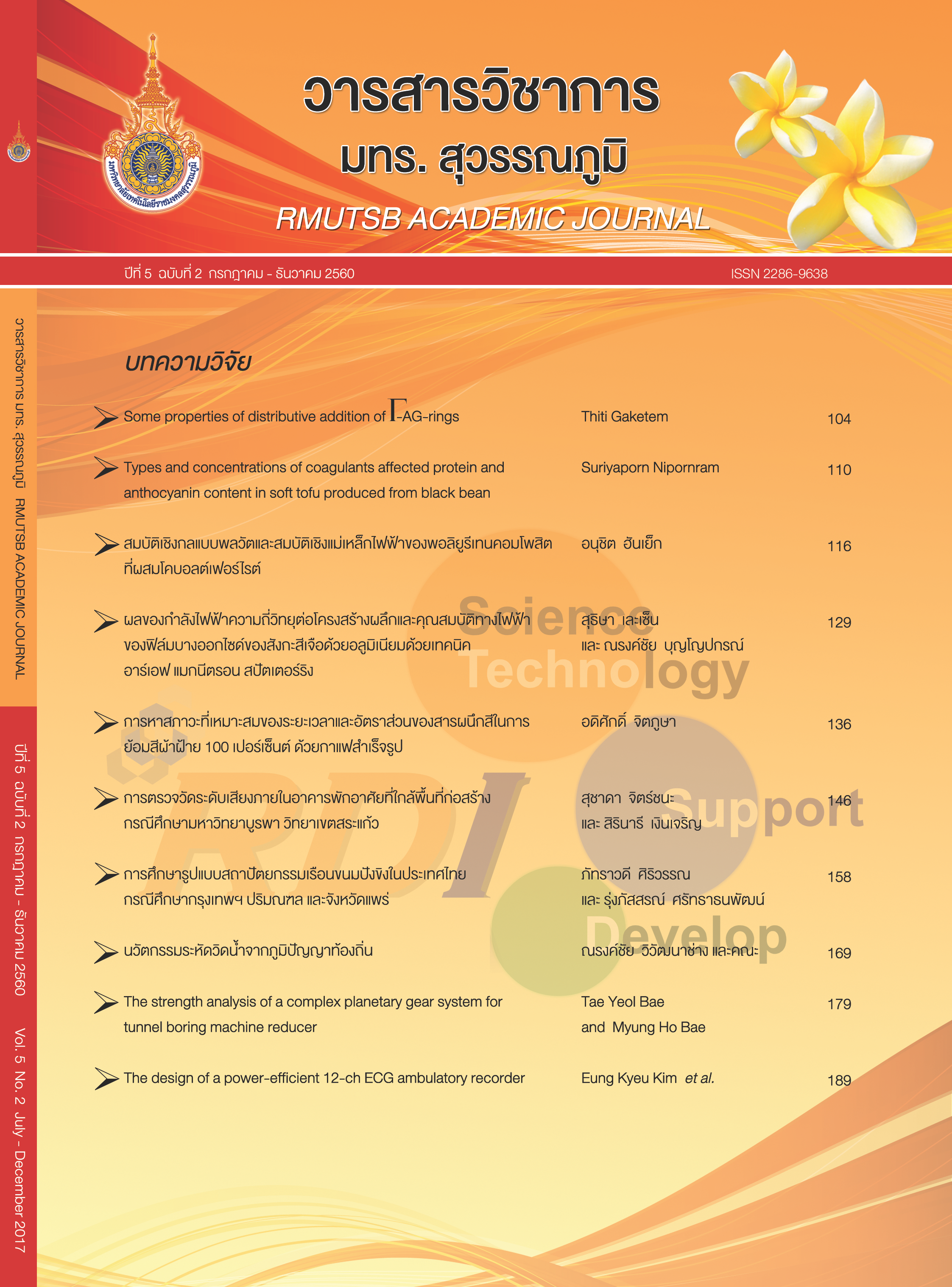การตรวจวัดระดับเสียงภายในอาคารพักอาศัยที่ใกล้พื้นที่ก่อสร้าง กรณีศึกษามหาวิทยาลัยบูรพา วิทยาเขตสระแก้ว
Main Article Content
Abstract
งานวิจัยนี้มีวัตถุประสงค์เพื่อตรวจวัดระดับเสียงภายในอาคารพักอาศัยที่ใกล้พื้นที่ก่อสร้างโดยเปรียบเทียบกับค่ามาตรฐาน รวมทั้งเพื่อหาระดับคุณภาพเสียง ดำเนินการตรวจวัดระดับเสียงเฉลี่ย (Leq) ระดับเสียงต่ำสุด (Lmin) และระดับเสียงสูงสุด (Lmax) ของขั้นตอนการทำฐานรากของงานก่อสร้าง เป็นเวลา 22 ชั่วโมง จำนวน 7 วัน ผลการศึกษาพบว่า Leq, 22 ชั่วโมง ขณะมีการก่อสร้างแต่ละวันไม่แตกต่างกันอย่างมีนัยสำคัญ (P>0.05) โดย Leq, 22 ชั่วโมง ภายในอาคารมีค่าในช่วง 45.4-56.9 dB(A) Lmin มีค่าในช่วง 33.9-34.5 dB(A) และ Lmax มีค่าในช่วง 78.2-86.4 dB(A) ผลเปรียบเทียบระหว่างการมีและไม่มีกิจกรรมก่อสร้าง พบว่า Leq, 7 ชั่วโมง ของการมีกิจกรรมก่อสร้างมีค่าในช่วง 49.0-61.2 dB(A) ซึ่งมากกว่าขณะไม่มีกิจกรรมก่อสร้างที่มีค่าในช่วง 37.1-40.3 dB(A) อย่างมีนัยสำคัญ (P<0.05) สำหรับ Leq, 4 ชั่วโมง ของการก่อสร้างแบบกิจกรรมหนักนั้น พบว่ามีค่าในช่วง 48.0-63.1 dB(A) มากกว่าการก่อสร้างแบบกิจกรรมเบาซึ่งมีค่าในช่วง 46.0-53.0 dB(A) อย่างมีนัยสำคัญ (P<0.05) เมื่อเทียบเกณฑ์คุณภาพเสียงของกรมควบคุมมลพิษ พบว่าเสียงภายในอาคารพักอาศัยจากการก่อสร้างอยู่ในระดับปานกลางถึงระดับดี ไม่มีผลกระทบต่อสุขภาพ แต่เกินมาตรฐานระดับเสียงภายในอาคารพักอาศัยของ U.S.EPA. จึงควรเฝ้าระวังหรือกำหนดมาตรการป้องกันเสียงที่เหมาะสม โดยเฉพาะป้องกันเสียงจากการใช้เครื่องมือก่อสร้างประเภทเลื่อยไฟฟ้าและการตอกเสาเข็มที่มีผลทำให้ระดับเสียงเพิ่มขึ้น
This research project was conducted to measure the indoor sound level in residential building nearby the construction area. The collected sound level was compared with standard level and to evaluated the sound quality level. The process started with measuring average sound level (Leq), minimum sound level (Lmin) and maximum sound level (Lmax) for 22 hours within 7 days. The results indicated that Leq, 22 hours, when the construction activities were operating each day, were not significantly different (P>0.05). In details, indoor sound level data of Leq, 22 hours were in range of 45.4 to 56.9 dB(A), Lmin were in range of 33.9-34.5 dB(A) and Lmax were in range of 78.2 to 86.4 dB(A). Comparison result between the construction activities and conversely situation was revealed that Leq, 7 hours of construction activities were in the range of 49.0-61.2 dB(A), which was higher than non-construction activities as in the range of 37.1-40.3 dB(A) with having significantly different (P<0.05). Likewise, Leq, 4 hours of heavy activities were in range of 48.0-63.1 dB(A) was differenced from non-heavy activities of construction that were in range of 46.0-53.0 dB(A) with having significantly different (P<0.05). Furthermore, the results were compared with the quality standard criteria of the Pollution Control Department. It was found that the noise quality in the residential building was equaled the medium to the good level and not had the health effect. However, the construction noise level of the residential buildings was exceeded to the U.S.EPA. standard. So it should be monitored or appropriate measuring should be taken. In particular, the noise protection from the construction tools such as chainsaws and pile drivers which could be increased noise levels
Article Details
Published manuscript are the rights of their original owners and RMUTSB Academic Journal. The manuscript content belongs to the authors' idea, it is not the opinion of the journal's committee and not the responsibility of Rajamangala University of Technology Suvarnabhumi


